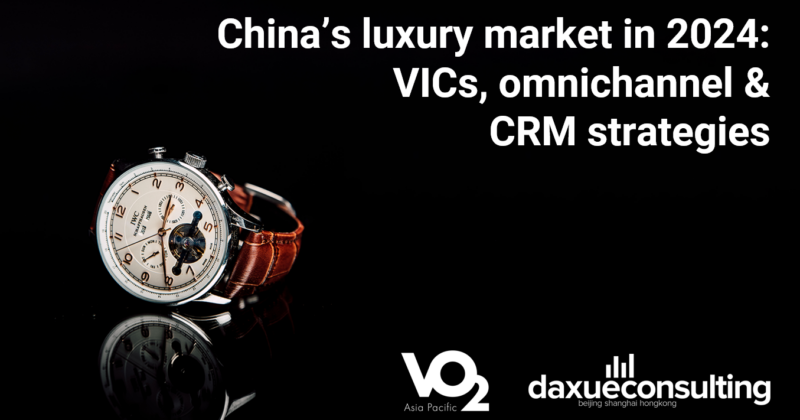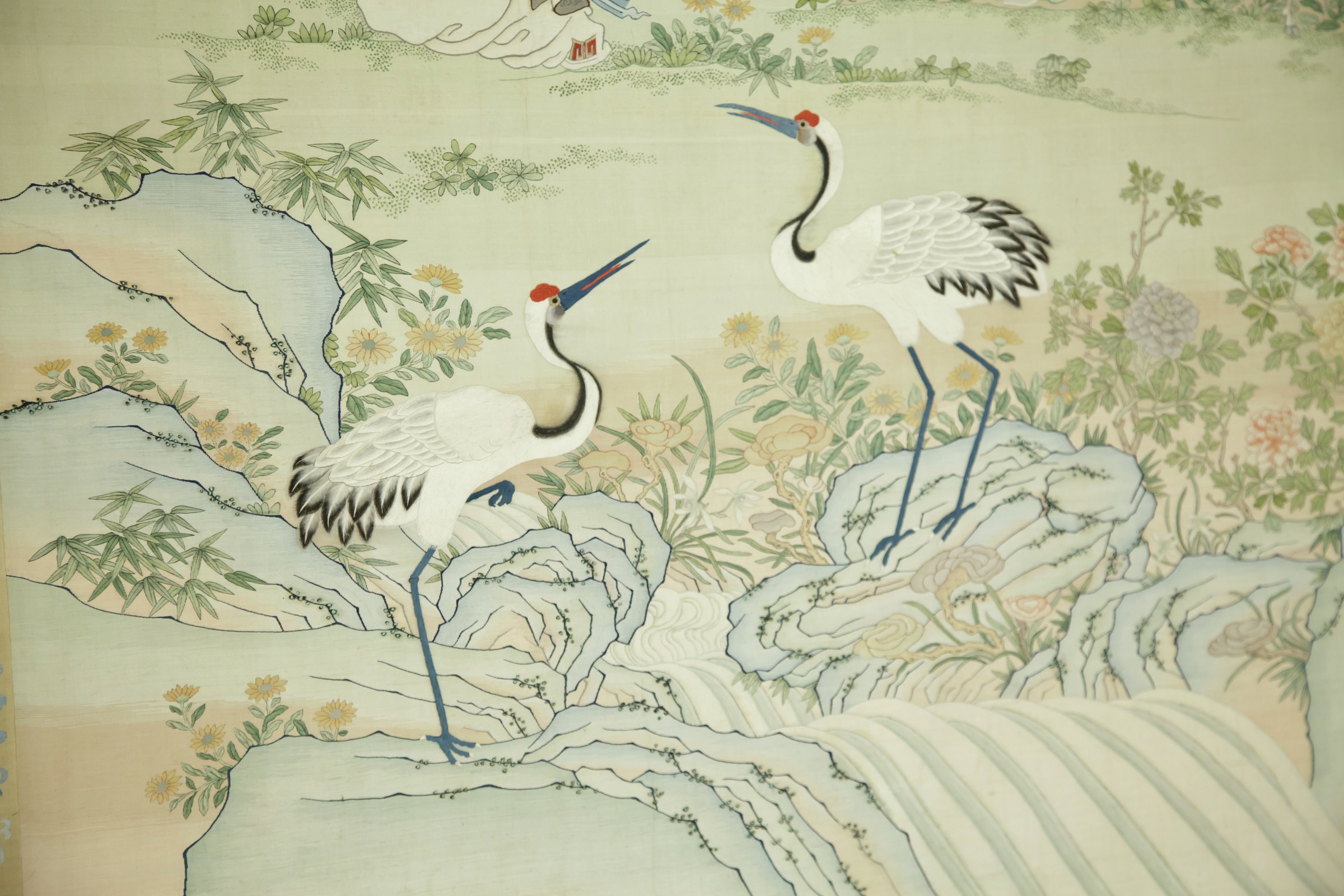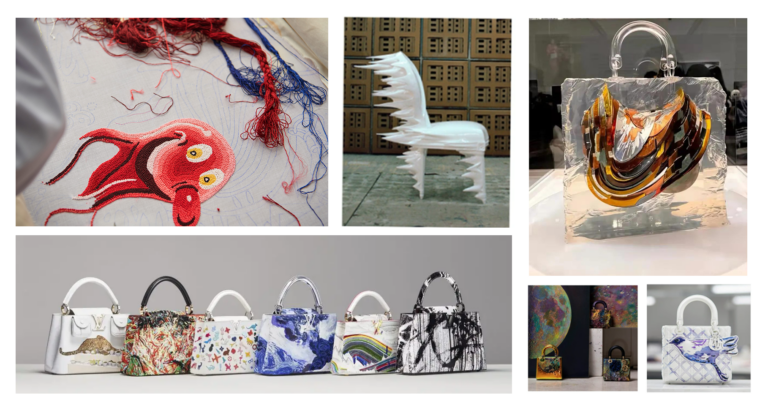The global art market is a multi-billion-dollar industry, playing a significant role in cultural exchange and economic development. While its artistic roots stretch back centuries, China’s art market has boomed in recent decades, becoming a major player on the global art scene. In recent years, the Chinese art market has witnessed a meteoric rise, solidifying its position as the second-largest globally in 2023, following the United States.

Source: Statista, designed by Daxue Consulting, Countries with the highest fine art and NFT sales revenues in 2023
From dynasties to recent decades: A journey through Chinese art history
Ancient roots of Chinese art
Dating back to the Song dynasty (960-1279), China has fostered a deep-seated tradition of artistic expression. This era saw the rise of high education among Chinese elites, leading to a heightened appreciation for art. Notably, landscape painting, or Shanshui (山水), which literally translates to “mountain-water” and depicts scenery, emerged as a prominent art form. Renowned artists like Fan Kuan and Ma Yuan gained recognition for their mastery of this style. Private art collections also began to appear among the Chinese nobility, marking the dawn of a new era of artistic patronage and prestige.
The communist era and cultural evolution
With the ascent of Mao Zedong in 1949, communist ideology challenged traditional notions of art in Chinese society. The Cultural Revolution of 1966-1976 sought to eradicate the elitist art culture of dynastic China, favoring instead art aligned with communist values. However, Deng Xiaoping’s leadership from 1978 signaled a shift, leading to the enactment of the Cultural Relics Protection Law in 1982. This legislation marked a turning point, with the state beginning to protect and embrace China’s cultural heritage once more.
The rise of the Chinese art market in the 1990s
The 1990s heralded significant changes in China’s socioeconomic landscape. The emergence of a new economic elite fueled a growing demand for luxury goods, including art. Simultaneously, China became increasingly appealing to foreign investors, paving the way for a burgeoning art market. This period saw the establishment of pivotal institutions such as the Red Gate Gallery and the Yan Huang Art Museum, signaling a renewed interest in both traditional and contemporary Chinese art.
Artistic tradition combined with embracing the future
Since the 1990s, China’s art market has grown significantly, marked by an increase in museums in China—from 3,589 in 2013 to 5,354 in 2018. Prominent new institutions like Tank Shanghai and a branch of the Pompidou Center, both established in 2019, highlight China’s engagement with both ancient traditions and contemporary art. The prestige of Chinese contemporary art is on the rise, exemplified by artists such as Yue Minjun gaining international recognition when Sotheby’s New York held an auction entirely dedicated to Asian contemporary art in 2006.

Source: National Museum of Taipei and The Metropolitan Museum of Art, Song Dynasty paintings
Economically, the art market in Mainland China was thriving, with 525 auction houses by 2017 and art becoming a popular investment. This growth is mirrored in the expanding interior design market in China. Historically, the 1990s saw Chinese art auctions primarily targeting foreign buyers, but the domestic audience has since become more significant.
Xu Zhen, one of the emerging Chinese artists on the contemporary art scene, uses sculptures, installations, and performances to challenge societal norms and cultural expectations. He explores globalization and identity through various mediums, often with a touch of humor. Known for blurring boundaries, he even turned himself into a brand created by his own art company, “MadeIn.” Xu Zhen’s thought-provoking work has landed him in major exhibitions worldwide, solidifying his place as a prominent figure in contemporary art.
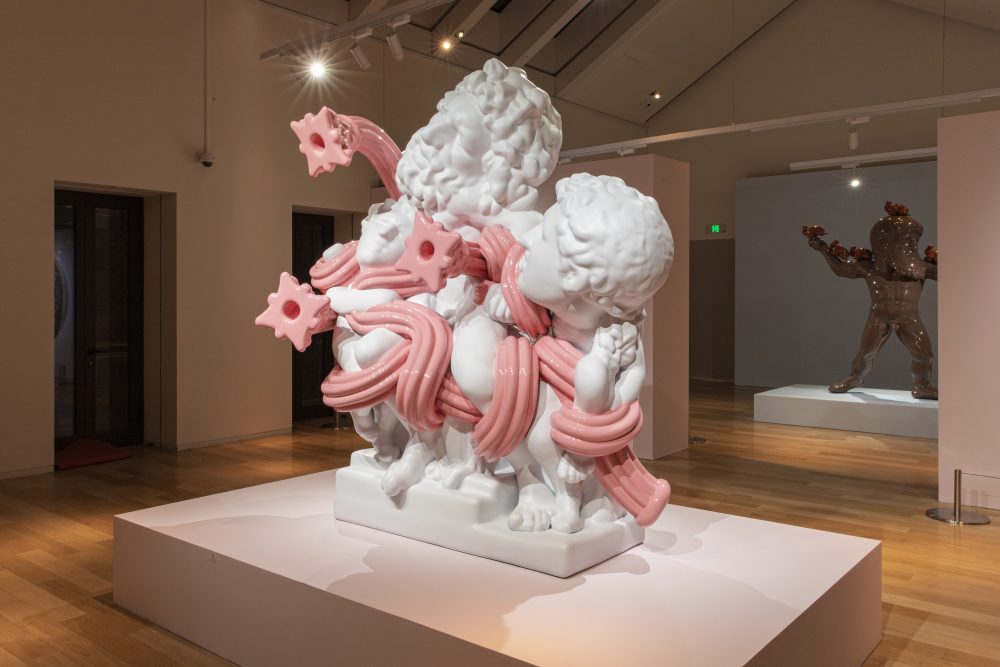
Source: Xu Zhen Art, “An Odyssey” exhibition in Hermes Maison, Shanghai
China’s art market meets digitalization
Digitalization has transformed consumer behavior in China, significantly impacting the art market through both domestic and international enterprises. Luxury brands, leveraging the influence of Key Opinion Leaders (KOLs) who target millennials, play an increasingly prominent role in this market. These influencers promote luxury products, set trends, and collaborate with Chinese artists to create special collections, thus boosting the visibility of Chinese art.
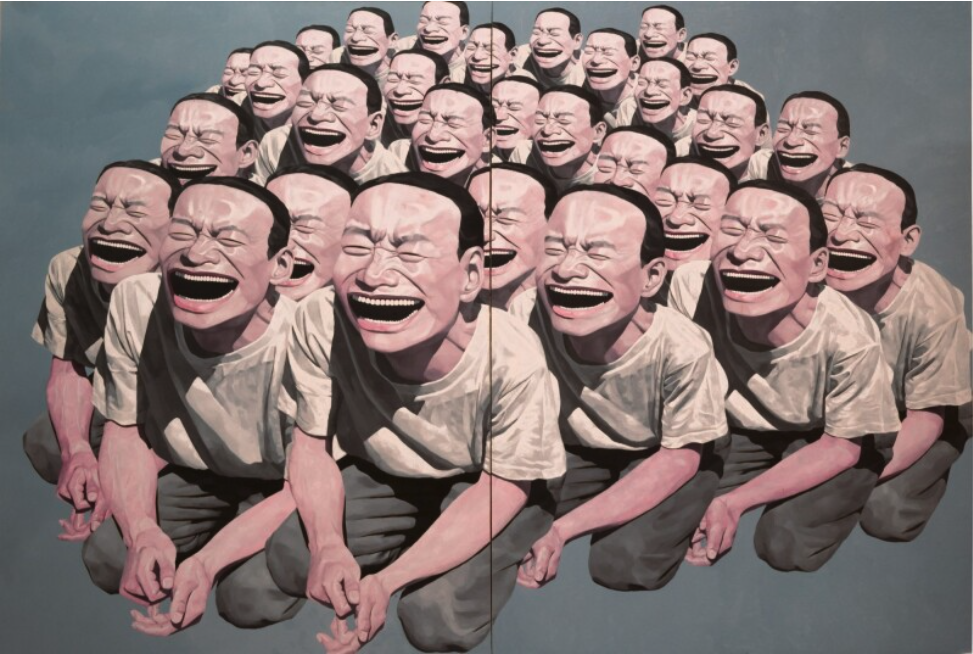
Picture source: Sotheby’s New York, Yue Minjun’s work in Sotheby’s New York
The art market mosaic: Insights into the Chinese art collectors
Consumer demographics: Generational preferences
Chinese collectors are well-informed and conduct thorough research before making purchases. This is increasingly recognized by global family office advisers and banks, which see higher demand for art advisory services among leading auction houses and private museums in China. These services include impartial expertise on the art industry, collection governance, and legacy planning.
Older generations in China have traditionally focused on collecting old masters and traditional Chinese art forms such as porcelain, calligraphy, vases, and ink painting. Younger generations, on the other hand, are increasingly interested in Western contemporary art, leading to a shift in collecting practices. It is not uncommon for younger collectors to sell traditional Chinese artworks to acquire contemporary pieces.
Young Asian art collectors, particularly Millennials and Gen Z, are shaking things up. They are not only interested in contemporary arts, but they are also drawn to modern mediums like sculptures, installations, and even digital art. This trend reflects a desire to connect with both contemporary and traditional Asian art, showing pride in their cultural heritage. Auction houses and art fairs are taking notice and are using online platforms to reach these younger, tech-savvy buyers. In 2023, WeChat achieved a record high of 60 million views on their livestream auctions and online bidding.
More than aesthetics: Art’s role in China’s investment market
Sales in China’s art market increased by 9% in 2023, reaching an estimated USD 12.2 billion. This growth was part of a post-pandemic spending boom. Art emerged as the best-performing luxury asset class in 2023, with an 11% rise in prices, outperforming other luxury investment assets.
Increasingly, art collecting in China is shifting towards an investment-driven approach. Artworks are frequently used as collateral for loans, allowing collectors to liquidate assets for further investment opportunities while maintaining ownership of their art. This strategic use of art as an investment tool is supported by banks and family offices, which assist wealthy families and individuals in expanding and managing their art collections, underscoring the growing financialization of art in the market.
E-Art expansion: New buyers fuel China’s online art market surge
Online sales have been a significant driver of growth in the Chinese art market. Both top-tier and smaller auction houses have noted that online channels are a primary source of new buyers. Most online sales in 2023 were to new buyers, highlighting the role of digital platforms in expanding the market and introducing art to a broader audience.
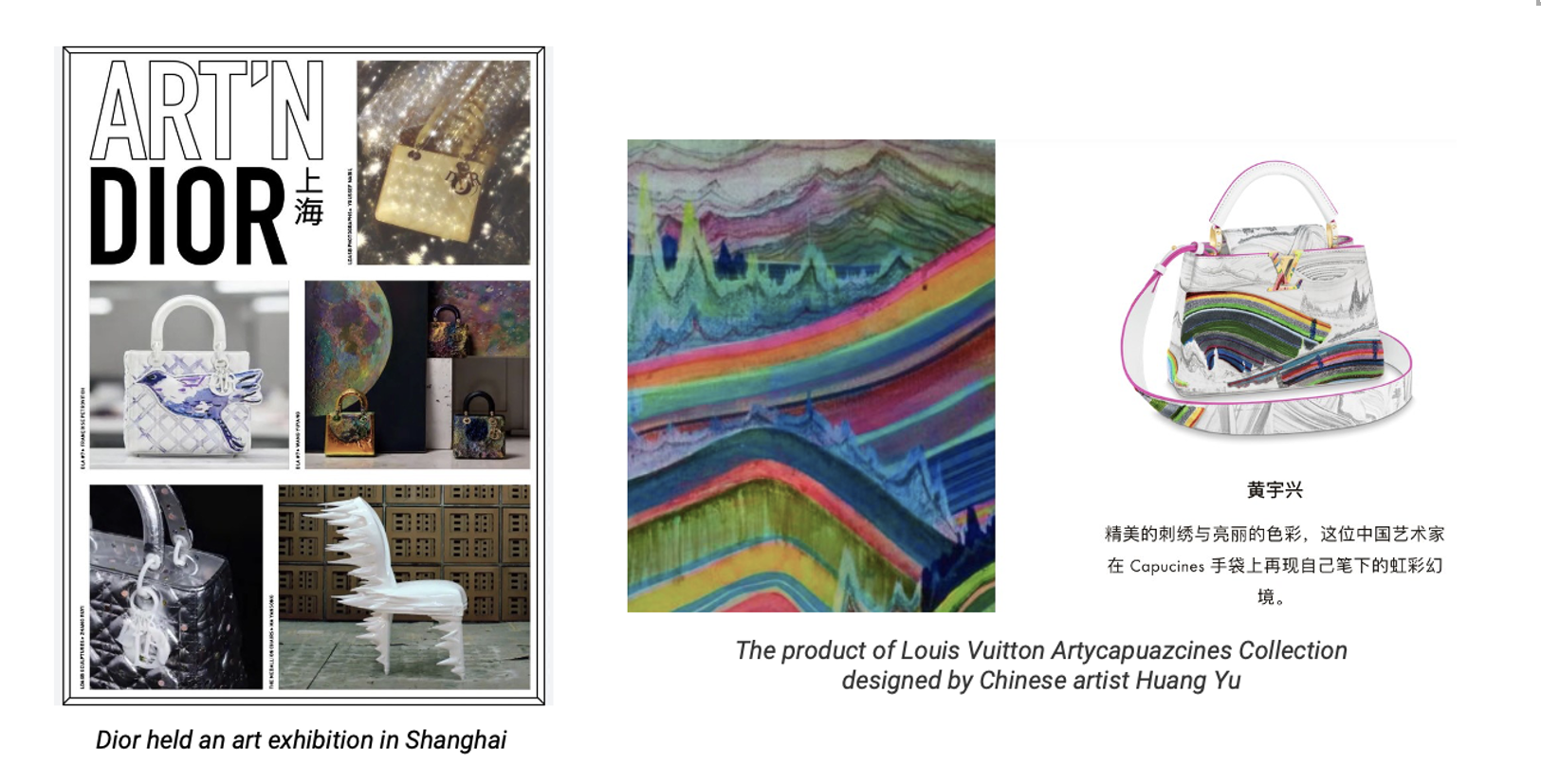
Source: Art China and Digital Ing, Luxury brands collaborating with Chinese artists
Between expression and suppressions: Challenges to address
As China continues to assert its influence on the global stage, its art market is expected to play an increasingly significant role in the international art scene. Chinese artists, collectors, and institutions will exert greater influence and command attention on a global scale, driving cross-cultural dialogue and collaboration. Yet, the future of China’s art market hinges on its ability to navigate challenges. By nurturing a vibrant art ecosystem that fosters innovation and artistic freedom, while ensuring responsible market practices, China can solidify its position as a leading force in the global art market. There are also some additional thoughts to consider:
- Technology’s impact: The continued influence of online platforms and virtual reality galleries will likely shape how art is accessed, bought, and sold. This development will also further enhance the immersive and interactive aspects of art consumption, driving engagement and market reach.
- Focus on provenance: Greater emphasis on establishing clear provenance records for art pieces will enhance trust and transparency in the market.
- Nurturing artistic talent: Investing in art education and fostering a thriving artistic community will ensure a constant stream of fresh talent and innovative artistic expressions.
Redefining investment: The role of art in China’s economic landscape
- China’s art market sales are ranked second in the world, just behind the United States with revenue reaching USD 4.9 billion in 2023.
- Older generations traditionally collect traditional Chinese art, while younger collectors show a preference for Western contemporary art.
- Art collecting in China is increasingly investment-driven, with artworks used as collateral for loans, supported by banks and family offices.
- Online sales have fueled growth in China’s art market, attracting new buyers and expanding the market’s reach.
- China’s art market is expected to grow in influence globally, with technology playing a key role in shaping how art is accessed and bought, and a focus on nurturing talent and establishing clear provenance records.
Contact us for in-depth art market research in China
The Chinese art market is a rapidly growing sector, characterized by shifting tastes, digital advancements, and increased international interest. Daxue Consulting provides specialized market research in China, offering in-depth insights into the art market landscape and consumer preferences.
Our expertise helps businesses navigate market dynamics and identify opportunities for growth. Through our consulting services, we enable clients to make data-driven decisions and develop effective strategies for success. Contact us today to discover how our services can support your objectives in the evolving Chinese art market.
Download our China luxury market report
